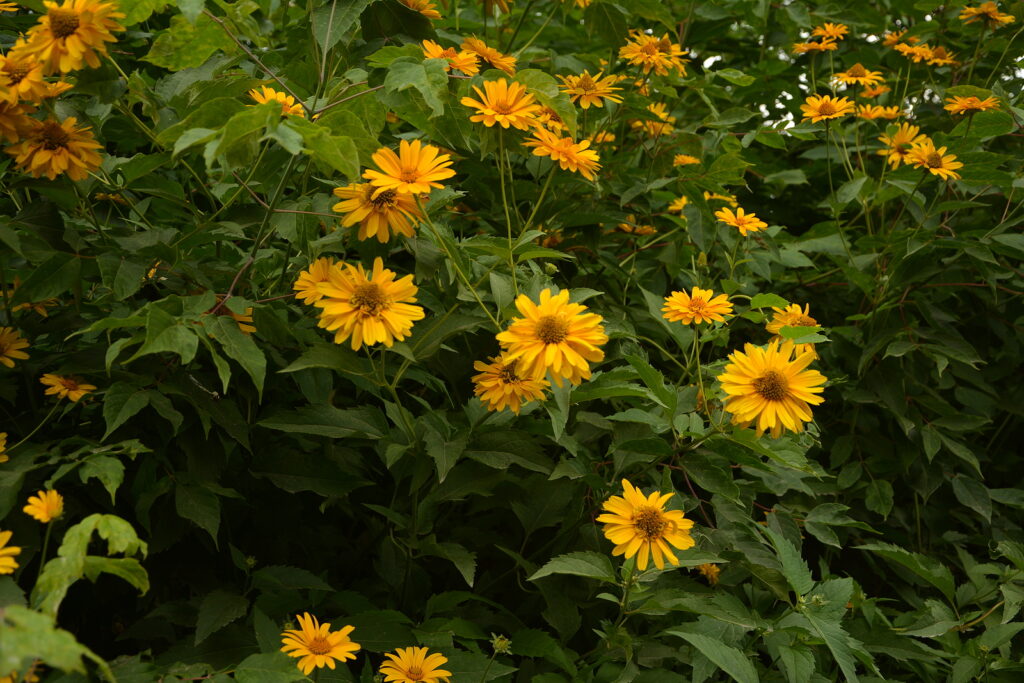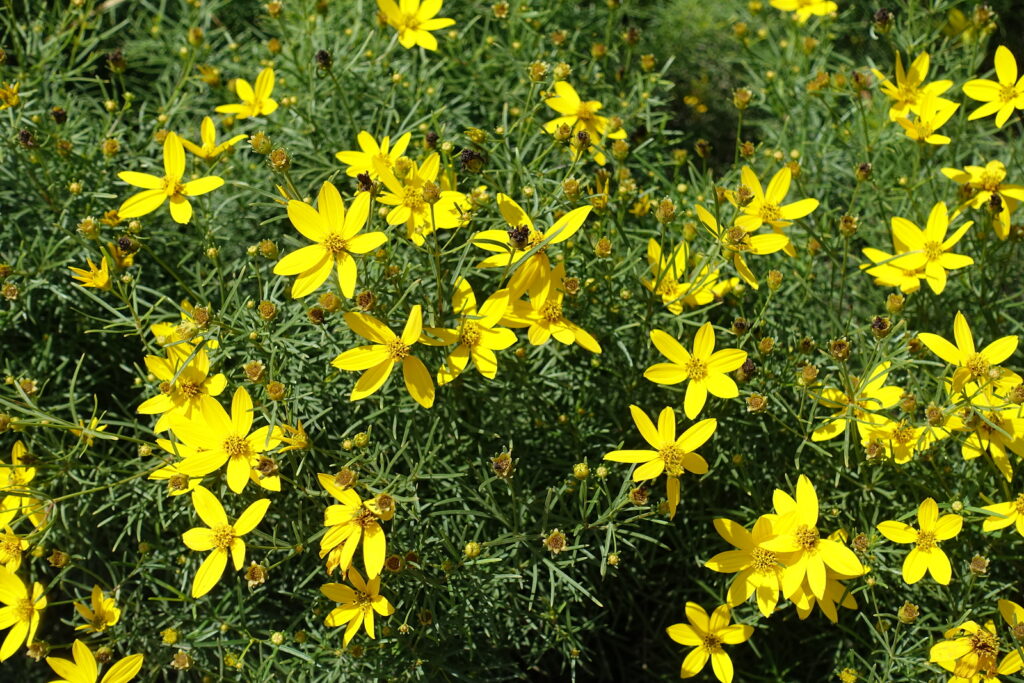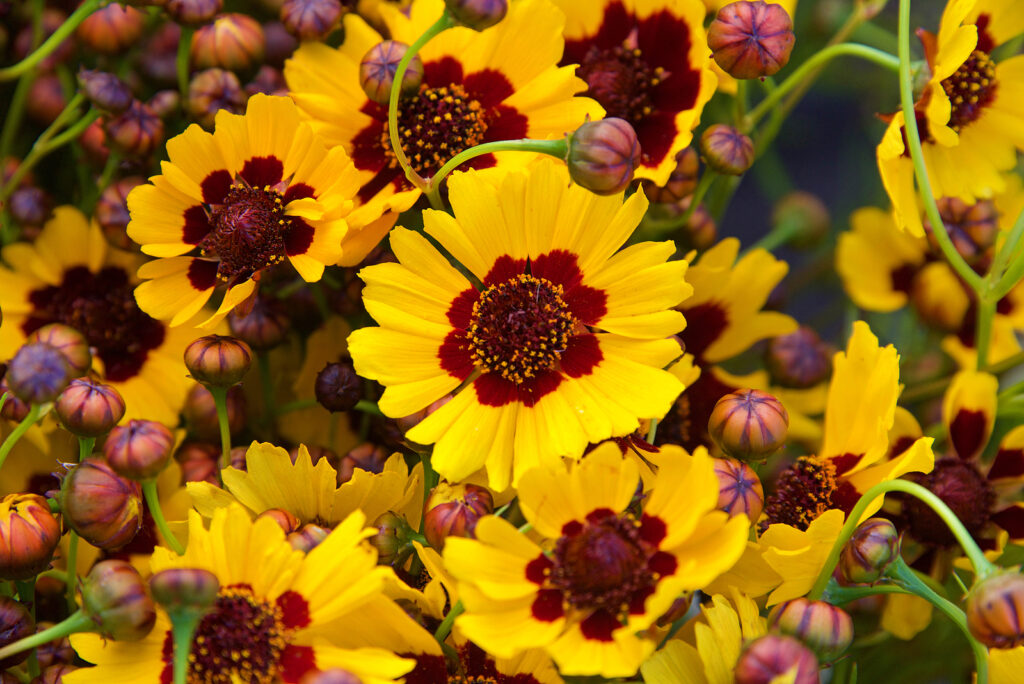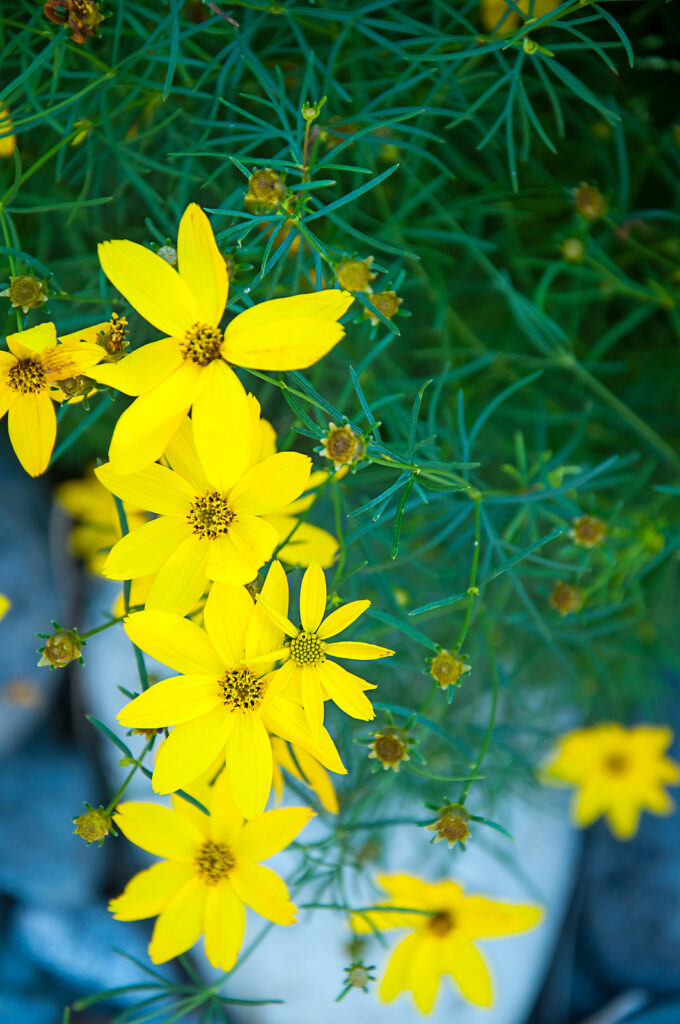Coreopsis–commonly called Tickseed–are long-blooming annuals and perennials that bear daisy-like single or double flowers. Tickseeds belong to the genus Coreopsis. There are about 80 to 100 species of tickseed, most bearing yellow-orange or gold flowers, but there are species with pale yellow or pink flowers.
Coreopsis is easily grown and attractive as bedding plants, meadow plants, and cut flowers. In the garden, they are most attractive when massed in large bands or groups.
Garden Success Products at Amazon:
- 10 pcs Stainless Steel Garden Hand Tool Set
- Flexi Hose with 8-inch Nozzle
- Gorilla Cart 4 Cu. Ft, 300-pound Capacity
- Neem Bliss 100-% Cold Pressed Neem Oil
- Safer Brand Insect Killing Soap
- Wildflower Seed Mix Attracts Hummingbirds and Butterflies
- Eden Brothers All Perennial Seed Mix
Coreopsis flowers are carried on leafless stems. The flowers consist of ray florets or petals surrounding a dense cluster of disk florets, called the “eye.” The leaves are either simple or cut in a pinnate or palmate fashion. The common name tickseeds refer to the black seeds that follow the flowers.
Coreopsis is native to North and Central America.

Get to know Coreopsis
- Plant type: Hardy annual or perennial
- Growing Zones and range: All zones as an annual; Zone 3 to 10 as a perennial
- Hardiness: Hardy to -30°F (-34°C); tolerant of heat and cold; most die back in winter;
- Height and width: 24 to 26 inches (61-91cm) tall; 12 to 24 inches (30-61cm) wide
- Foliage: Lacy, finely cut leaves, simple or entire, pinnate or palmate
- Flowers: Daisylike single or double flowers from one to several inches wide
- Flower colors: Yellow, orange, maroon, bronze, and shades of red, often with a contrasting band of color surrounding purplish brown centers.
- Bloom time: Summer in most regions; spring through fall in Zone 8 and warmer
- Uses: Plant in mass; use in beds and borders
- Common name: Coreopsis, Tickseed
- Botanical name: Coreopsis spp.
- Family: Compositae
- Origin: Woodlands in North and Central America
Where to plant Coreopsis
- Plant Coreopsis in full sun.
- Grow Coreopsis in average to sandy, well-drained soil.
- Coreopsis prefers a soil pH of 6.5 to 7.
Coreopsis uses and companions
- Use Coreopsis grandiflora in informal and formal gardens; allow it to self-seed in meadows and cottage gardens. It is an excellent cut flower.
- Use Coreopsis rosea as a foreground planting or path edging; it combines well with blue flowers.
- Use Coreopsis verticillata to provide a fine texture contrast to bolder flowers and foliage; ‘Moonbeam’ combines well with almost any other flower color.
- Good garden companions for Coreopsis include Asclepias tuberosa, Convolvulus mauritanicus, Nepeta, Penstemon, Salvis, Sisyrinchium striatum.

When to plant Coreopsis
- Start Coreopsis from seed in spring or fall.
- Start perennial Coreopsis seeds indoors 8 weeks before the last frost in spring; start annual tickseed seeds indoors 6 weeks before the last frost.
- Sow seed outdoors after the danger of frost is past in spring.
- Set container-grown Coreopsis in the garden after the last spring frost; harden off plants for a few days in the shade before planting them in the garden.
Planting and spacing Coreopsis
- Sow seed indoors in six-pack or flats filled with moist, sterile potting soil. Cover plants with 1/8 inch of soil and keep them at 65° to 75°F (18°-24°C) in bright light or under fluorescent light. Seeds will germinate in about 7 days.
- Sow seed outdoors in evenly prepared soil; sow seed 1/8 inch deep.
- Space Coreopsis 12 to 24 inches (30-61cm) apart.
- If annual plants are leggy, bury the stems deeper than they grew to the bottom two leaves.
- Plant container-grown perennial Coreopsis at the same depth at which they grew.

How to water and feed Coreopsis
- Coreopsis needs evenly moist soil until well-established; established plants are fairly drought tolerant.
- Mulch plants with 2 to 3 inches (5-7.6cm) of aged compost or shredded leaves to conserve soil moisture.
- Fertilize Coreopsis occasionally with an all-purpose fertilizer.
Coreopsis care and propagation
- Remove spent Coreopsis blooms to encourage new blooms.
- Tall varieties can be supported by a stake or ring-type support.
- When annual Coreopsis become too branched and spent, remove, and replace them.
Coreopsis pests and diseases
- Coreopsis has few pests apart from rabbits.
Coreopsis propagation
- Seeds germinate in 7 to 14 days at 55° to 60°F (13°-16°C).
- Divide Coreopsis every 3 or 4 years. Plants can also be started from seeds or cuttings.

Coreopsis varieties to grow
- Coreopsis auriculata, Mouse-ear Coreopsis. Perennial grows 1 to 2 feet (.3-.6m) tall and spreads by stolons, bears solitary, yellow-orange 2-inch (5cm) wide flowers; ‘Nana’ is an 8-inch (20cm) tall cultivar.
- C. grandiflora, Large-flowered Coreopsis. Perennial produces golden-yellow daisies on 3-foot (.9m) plants; there are single, semi-double, and double-flowered cultivars; ‘Early Sunrise’ blooms the first year from seeds.
- C. lanceolata, Lance-leaved Coreopsis. Perennial grows 12 to 24 inches (30-61cm) tall; flowers from late spring to midsummer; there are single-, semi-double, and double-flowered cultivars.
- C. rosea, Pink Coreopsis. Bears rosy-pink 1-inch (2.5cm) wide flowers with yellow centers; the plant grows 12 to 24 inches (30-61cm) tall with needlelike leaves.
- C. tinctoria, Calliopsis, plains Coreopsis. The erect plant grows 1 to 4 feet (.3-1.2m) tall with solitary, yellow 1- and 2-inch-wide daisylike flowers; flowers are bright yellow with a maroon center; cultivars are marked with maroon, dark red, or purple-brown.
- C. tripteris, Tall tickseed, Atlantic Coreopsis. Wildflower grows 3 to 9 feet (.9-2.7m) tall with clusters of pale yellow 2-inch (5cm) wide flowers.
- C. verticillata, Threadleaved C.oreopsis. A is fine-textured, feathery foliage to 18 to 36 inches (45-91cm) tall. Cultivars ‘Moonbeam’ has beautiful pale yellow flowers, and ‘Zagreb’ has golden-yellow flowers.
Coreopsis Frequently Asked Questions
Q: What growing conditions do tickseed prefer?
A: Coreopsis is happy in almost any well-drained garden soil in full sun. They are drought-resistant and an outstanding choice for hot, difficult places.
Q: Can tickseed be started from seed?
A; Yes. It tickseed (Coreopsis) is sown in early spring indoors, and the plants will bloom the first year. You can also plant tickseed outdoors in summer to bloom the next year. Tickseed can also be propagated by division.
Q: How do I start Coreopsis from seed?
A: Start coreopsis seeds indoors 8 to 10 weeks before the last spring frost. The stored seed must be stratified (refrigerate for 3 to 4 weeks) before sowing. Transplant the seedlings to larger containers when they have two to three true leaves. Move them outdoors when their roots fill the pots after the last spring frost.
Q: What plants should I grow tickseed with?
A: A favorite Coreopsis planting is the combination of tickseed plat with Shasta daisies in front of delphiniums. Tickseed produces bright yellow daisy-like flowers off and on all summer if the faded flowers are removed. Coreopsis is well suited for patio containers and hanging baskets.



